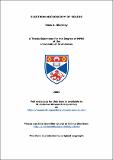Files in this item
Electron microscopy of solids
Item metadata
| dc.contributor.advisor | Zhou, Wuzong | |
| dc.contributor.author | Blackley, Ross A. | |
| dc.coverage.spatial | 137 p. | en_US |
| dc.date.accessioned | 2018-03-13T11:35:57Z | |
| dc.date.available | 2018-03-13T11:35:57Z | |
| dc.date.issued | 2005 | |
| dc.identifier.uri | https://hdl.handle.net/10023/12930 | |
| dc.description.abstract | A series of compounds with general composition Ba1+/-xBi1-/+xO3 were prepared (x=0.05, 0.1, 0.2, 0.4, 0.5). The compounds were then studied by means of selected area electron diffraction and high resolution transmission electron microscopy. It was found that for a small change in the cation composition there was little or no overall change to the basic perovskite unit cell structure, whereas for the compounds with more marked changes in cation composition subtle changes to the basic unit cell were recorded. The evidence for transformation is presented by changes in the diffraction patterns and HRTEM imaging. These changes are compared with the results expected and observed for the basic perovskite unit cell for the standard BaBiO3 sample. It is thought that these changes in structure are brought about by the ordering of the Bi cation into much more complicated structures. This method of structural determination can indeed be applied to other complex materials. It has been shown that in the duration of this project that high resolution electron microscopy is invaluable in the structural determination of both microporous and mesoporous materials. The identification of pore diameters ranging from 2-20nm is of particular interest to many workers in this research field. It is shown that direct observation of these systems at sub-nanometer resolution and of loaded nanoparticles within is potentially of great value in the understanding and therefore the manipulation of these structures. It was concluded that the observation of certain nanoparticles directly loaded into the porous channels could lead to problems, however HRTEM (High Resolution Transmission Electron Microscopy) had sufficient resolution to allow the determination of the size and location of these particles. Chemical analysis using EDS was used to identify and quantify the loaded metal within the pore channels or in many cases out with the target region in these materials. It was shown that scanning electron microscopy is a more than valuable tool in the study of morphology and elemental analysis from many solids. | en_US |
| dc.language.iso | en | en_US |
| dc.publisher | University of St Andrews | |
| dc.subject.lcc | QC176.8R3B6 | |
| dc.subject.lcsh | Solids--Effect of radiation on. | en |
| dc.subject.lcsh | High resolution electron microscopy. | en |
| dc.subject.lcsh | Transmission electron microscopy. | en |
| dc.subject.lcsh | Electrons--Diffraction. | en |
| dc.subject.lcsh | Bismuth trioxide. | en |
| dc.title | Electron microscopy of solids | en_US |
| dc.type | Thesis | en_US |
| dc.type.qualificationlevel | Doctoral | en_US |
| dc.type.qualificationname | MPhil Master of Philosophy | en_US |
| dc.publisher.institution | The University of St Andrews | en_US |
This item appears in the following Collection(s)
Items in the St Andrews Research Repository are protected by copyright, with all rights reserved, unless otherwise indicated.

